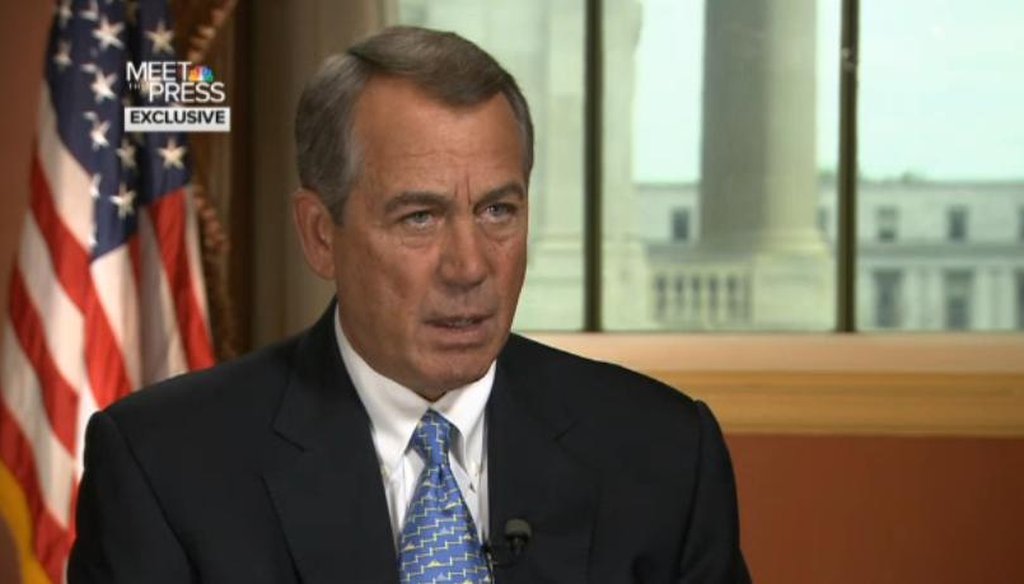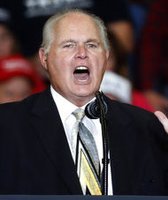Stand up for the facts!
Our only agenda is to publish the truth so you can be an informed participant in democracy.
We need your help.
I would like to contribute

House Speaker John Boehner, R-Ohio, on NBC's "Meet the Press."
Warning: The following fact-check may upset your stomach.
On NBC’s Meet the Press, House Speaker John Boehner, R-Ohio, was asked if there was too much money in politics. He offered a novel answer.
"We spend more money on antacids than we do on politics," Boehner claimed.
Before you reach for the Tums, Boehner’s claim is incorrect. It rates False.
Boehner spokesman Kevin Smith pointed us to two articles. One from the trade publication Drug Topics spoke of a $10 billion yearly market for antacids. The other from the nonprofit organization that tracks political money, the Center for Responsive Politics, said total spending on federal campaigns in 2014 was $3.7 billion.
Sign up for PolitiFact texts
The problem is, that antacid number was for sales worldwide. In America, the total is about $2 billion. We found that estimate from a couple of sources. The business website Statista.com reported $1.96 billion in sales of antacid tablets in 2013. That excludes liquid antacids.
We found 2011 figures for both tablets and antacids. Liquid antacid sales add about 5 percent more to the total -- $1.6 billion in tablets compared to about $83 million for liquids. Assuming the same trend held in 2013, we’re looking at a total sales figure in America around $2 billion.
That’s a lot of indigestion, but it’s less than the amount spent on the 2014 federal elections.
The most recent data from the Center for Responsive Politics actually puts the total closer to $3.8 billion. That includes spending by the candidates’ campaigns, the party committees, Super PACs and outside groups. Even if we limit the tally just to candidates and the parties, there was still more than $2.7 billion spent.
Boehner’s comparison gets into deeper trouble if state-level races are factored in. The National Institute on Money in State Politics reports almost $3 billion in spending in 2014 to elect governors and members of state legislatures.
That’s nearing $6 billion spent in total. Boehner’s comparison doesn’t come close.
Also Sunday, the sports world was still buzzing about the Floyd Mayweather/Manny Pacquiao fight, and how much money the pay-per-view event generated.
In the lead up to the fight, boxing commentator Jim Lampley said HBO and Showtime projected that 3 million homes would pay $99.99 to watch the fight. Add in revenues generated at the MGM Grand Arena, and Lampley said the fight would produce $400 million in revenue.
That is so much money, Lampley said, that Pacquiao and Mayweather would earn roughly $138,000 per second during the fight. So much money, that the 12-round fight would create more revenue than "the annual GDP of 29 different countries."
We’re KO’ing that GDP claim. It rates Pants on Fire.
There are only six countries with an annual gross domestic product of less than $400 million, according to the World Bank’s 2013 ranking. (GDP is the monetary value of all goods and services that an economy produces in a year and a standard measurement of an economy’s size).
All six are tiny island nations (Micronesia, $316 million; Sao Tome and Principe, $311 million; Palau, $247 million; Marshall Islands, $191 million; Kiribati, $169 million; Tuvalu, $38 million).
The country with the seventh-lowest GDP is Tonga, with a GDP of $466 million, just surpassing the estimated revenue of the Mayweather-Pacquiao fight.
One possible explanation for the large discrepancy with Lampley’s claim is the fact that the World Bank doesn’t have GDP data for 22 economies. But of the 22, most are territories of other nations -- for example the United States territory of Guam or the British territory of the Cayman Islands. Only six without a 2013 World Bank GDP are fully independent nations: Andorra, North Korea, Liechtenstein, Myanmar, Somalia and Syria. And all have GDPs well north of $400 million.
Our Sources
See individual fact-checks.














































